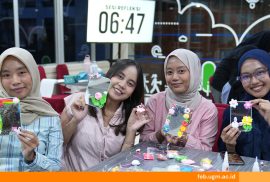
Amidst the rapid development of digital technology, artificial intelligence (AI) has become an essential part of modern marketing strategies. Dr. Sahid Susilo Nugroho, M.Sc., a lecturer at the Faculty of Economics and Business, University of Gadjah Mada, and an expert in digital marketing, said that AI plays a role in the creative process and accelerates the production of promotional content without reducing its emotional relevance and visual aesthetics.
Sahid explained that various AI-based tools are now used in the creative industry. He cited examples such as ChatGPT, Claude AI, DeepSeek, and Jenni.ai, which can assist in idea generation and content creation, such as copywriting. For voice narration needs, platforms like TTSMaker and ElevenLabs are available. AI is also utilised to convert voice into animated videos using services like Adobe Express or Hailuo.
“For visual processing and content editing, some tools that can be used include product-photos.com, CapCut, Polish, Pika, and Runway,” he explained to dozens of SME practitioners in the DIY and Central Java regions during a recent AI Training for Marketing Content Design at FEB UGM.
During the event, participants were invited to try designing logos and posters using Canva and BrandCrowd, and product packaging using the mockupbro.com and pacdora.com platforms. These technologies are designed to support content production efficiency while maintaining quality and visual appeal in line with brand characteristics.
Sahid also explained prompt engineering, which is crafting the proper commands to AI to produce outputs that meet expectations. According to him, a good prompt typically includes key elements such as context, clear instructions, example outputs, desired output format, and specific limitations.
Furthermore, participants were also equipped with the ability to create effective and engaging product offers. Technical information such as size, colour, material, and distribution permits remain essential. However, it is recommended that they be packaged in a narrative format that emphasises the product’s benefits and solutions to consumer needs. Sahid also discussed strategies for using hashtags in more detail. Hashtags should be tailored to the product category, target market location, consumer segmentation, and the product’s design and functional values.
Sahid also explained how to create content that has the potential to go viral, both organically and through paid methods. Organic methods involve regularly creating and sharing content through Instagram’s reels, feed, or story features and actively interacting with other accounts to improve the exposure algorithm. On the other hand, paid methods are becoming more effective and affordable thanks to the presence of advertising features on Instagram, Facebook, and TikTok, which are increasingly accessible, including for MSME players.
During the event, Sahid also provided technical guidance on optimizing an Instagram account to effectively support business promotion. Some steps that can be taken include converting the account to a business account, setting up cross-posting features, improving the quality of uploaded media, and enabling public search features to make content easier for potential customers to find.
Report by: Orie Priscylla Mapeda Lumalan
Editor: Kurnia Ekaptiningrum
Sustainable Development Goals









